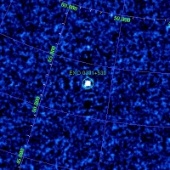ESA Science & Technology - Science Results
Science Results
Science Results
Images taken with the Wide Field Planetary Camera 2 on board Hubble were combined to create a detailed view of the supernova remnant N 63A, located in the Large Magellanic Cloud, showing the impact on the ambient gas clouds.
Published: 7 June 2005
Among INTEGRAL's science goals is the study of objects residing at the centre of our galaxy, and the physical processes at play in this region.
Published: 25 May 2005
Published: 11 May 2005
New results from simulations based on Cluster data are providing insight in the processes that transfer solar wind plasma into the Earth's magnetotail when the Interplanetary Magnetic Field is strongly northward oriented.
Published: 28 April 2005
Based on observations by the ESA/NASA SOHO mission a Chinese-German team of scientists have identified the magnetic structures in the solar corona where the fast solar wind originates.
Published: 22 April 2005
Published: 14 March 2005
Scientists using XMM-Newton have discovered an x-ray glow on Jupiter due to x-rays from the Sun being reflected back off the planet's atmosphere.
Published: 7 March 2005
Using ESA's XMM-Newton observatory and the European Southern Observatory's Very Large Telescope, scientists have discovered the most distant massive structure in the Universe.
Published: 2 March 2005
Published: 1 March 2005
Around the time of the descent of the Huygens probe in Titan's atmosphere on 15 January 2005, ground based observations of Saturn's largest moon were made with the Very Large Telescope (VLT) in Chile during the nights from 14-16 January.
Published: 1 March 2005
Scientists using XMM-Newton have observed a relativistic Fe line in the mean X-ray spectra of type-1 and type-2 active galactic nuclei.
Published: 23 February 2005
On 10 February, the ESA Science Programme Committee approved unanimously the extension of the Cluster mission, pushing back the end date from December 2005 to December 2009.
Published: 18 February 2005
Published: 17 February 2005
Published: 16 February 2005
Multipoint measurements from the Cluster spacecraft have revealed, for the first time, a direct observation of a three dimensional geometry for a hitherto unexplained type of magnetic reconnection.
Published: 4 February 2005
The High-Mass X-ray Binary V 0332+53 (EXO 0331+530), currently undergoing a dramatic outburst, was a Target of Opportunity (TOO) for an INTEGRAL observation on 6-10 January 2005.
Published: 20 January 2005
A study based on the multipoint measurements of the Cluster spacecraft provides new details on the typical size of the spectacular transient high-speed plasma flows in the Earth's magnetotail.
Published: 13 December 2004
A recent study based on Cluster data has provided new insights into an existing technique to determine the type of an interplanetary magnetic field discontinuity and sheds light on the solar wind dynamics.
Published: 25 November 2004
On 8 November 2004, more than 70 scientists from China, Europe, Russia and USA gathered to discuss the first results of the Double Star mission that provide new insights in the Earth's magnetosphere.
Published: 22 November 2004
Scientists working on INTEGRAL and XMM-Newton, ESA's two high-energy observatories, have published details of recent observations on the galactic centre and a supernova.
Published: 9 November 2004
—
20 Items per Page

















